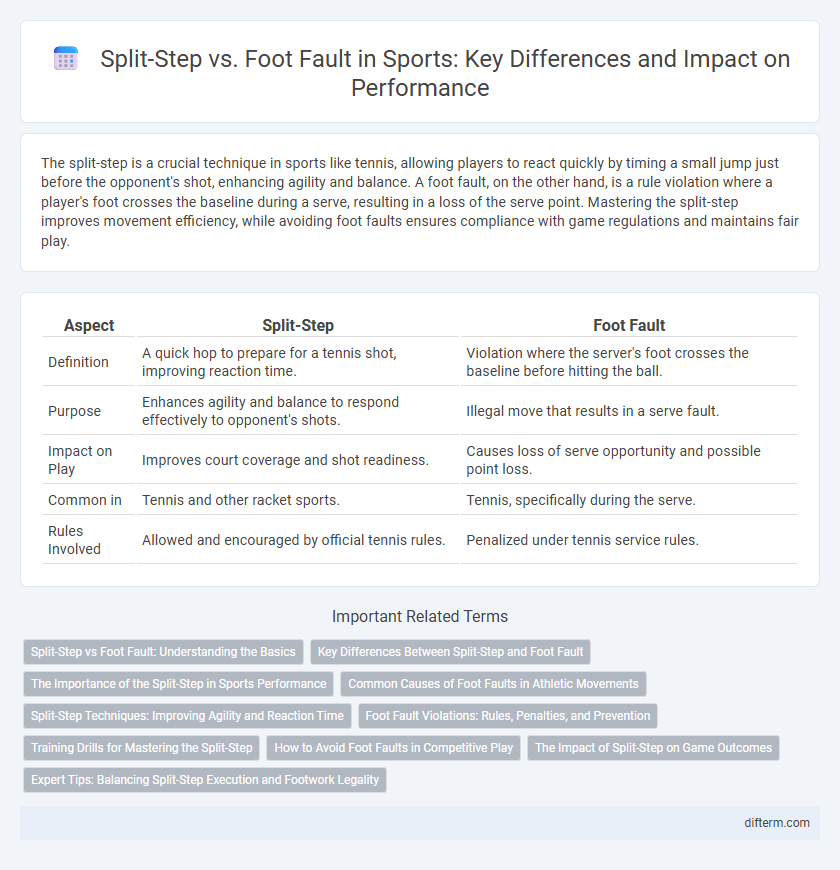The split-step is a crucial technique in sports like tennis, allowing players to react quickly by timing a small jump just before the opponent's shot, enhancing agility and balance. A foot fault, on the other hand, is a rule violation where a player's foot crosses the baseline during a serve, resulting in a loss of the serve point. Mastering the split-step improves movement efficiency, while avoiding foot faults ensures compliance with game regulations and maintains fair play.
Table of Comparison
| Aspect | Split-Step | Foot Fault |
|---|---|---|
| Definition | A quick hop to prepare for a tennis shot, improving reaction time. | Violation where the server's foot crosses the baseline before hitting the ball. |
| Purpose | Enhances agility and balance to respond effectively to opponent's shots. | Illegal move that results in a serve fault. |
| Impact on Play | Improves court coverage and shot readiness. | Causes loss of serve opportunity and possible point loss. |
| Common in | Tennis and other racket sports. | Tennis, specifically during the serve. |
| Rules Involved | Allowed and encouraged by official tennis rules. | Penalized under tennis service rules. |
Split-Step vs Foot Fault: Understanding the Basics
The split-step is a crucial tennis technique involving a small hop just before the opponent's shot to improve reaction time and balance, enhancing court coverage. In contrast, a foot fault occurs when a player's foot crosses the baseline during a serve, resulting in a fault and loss of the serve opportunity. Understanding the difference between the split-step and foot fault is essential for players to optimize performance while adhering to game rules.
Key Differences Between Split-Step and Foot Fault
The split-step is a dynamic movement used in sports like tennis to improve reaction time and balance before an opponent's shot, involving a small hop to prepare for quick directional changes. In contrast, a foot fault is a rule violation occurring when a player steps on or over the baseline during service, resulting in the loss of the serve point. Key differences lie in the purpose--split-step enhances performance and foot fault penalizes misconduct--and the sport mechanics where split-step aids agility, while foot fault enforces fair play regulations.
The Importance of the Split-Step in Sports Performance
The split-step enhances agility and reaction time by allowing athletes to quickly transition between movements, crucial in sports like tennis, volleyball, and badminton. Proper execution of the split-step minimizes the risk of foot faults, ensuring compliance with game rules while maximizing on-court mobility. Mastery of the split-step directly contributes to improved court positioning and precision in dynamic sports environments.
Common Causes of Foot Faults in Athletic Movements
Common causes of foot faults in athletic movements include improper weight distribution, inadequate foot placement, and premature toe lifts during the split-step. Athletes often experience foot faults when their momentum disrupts balance, leading to violations such as stepping beyond the baseline or failing to maintain contact with the ground. Training that emphasizes precise foot alignment and controlled weight shifts during the split-step can significantly reduce foot fault occurrences in sports like tennis and volleyball.
Split-Step Techniques: Improving Agility and Reaction Time
Split-step techniques enhance agility and reaction time by enabling players to quickly transition from a stationary position to dynamic movement, crucial in sports like tennis and badminton. Proper execution involves a balanced, slight jump just before the opponent's stroke, allowing immediate directional changes and reducing the risk of foot faults. Consistently practicing split-step improves foot placement precision, preventing foot faults while maximizing responsiveness during high-intensity gameplay.
Foot Fault Violations: Rules, Penalties, and Prevention
Foot fault violations occur when a player steps on or over the baseline during a serve, violating tennis rules and resulting in a fault or double fault penalty. Umpires enforce strict line adherence to maintain fair play, with repeated foot faults leading to loss of serve or point penalties in professional matches. Prevention techniques include practicing proper foot placement, maintaining balance during the split-step, and using video analysis to correct serving stance errors.
Training Drills for Mastering the Split-Step
Training drills for mastering the split-step enhance foot speed and timing by emphasizing quick lateral movement and explosive reactions. Cone drills and mirror exercises simulate match scenarios, improving an athlete's ability to avoid foot faults while maintaining optimal court positioning. Consistent practice with resistance bands and plyometric jumps further develops the muscle coordination necessary to execute a precise split-step during competitive play.
How to Avoid Foot Faults in Competitive Play
To avoid foot faults in competitive tennis, players must consistently ensure their feet do not cross the baseline before the serve is struck, maintaining proper positioning behind the service line. Incorporating a controlled and balanced split-step technique improves reaction time without compromising foot placement, reducing the risk of stepping over the line. Regular practice with focus on footwork drills and using video analysis promotes muscle memory and adherence to serve rules, crucial for minimizing foot fault violations during matches.
The Impact of Split-Step on Game Outcomes
The split-step enhances player readiness by improving reaction time and enabling quicker directional changes, directly influencing game outcomes in tennis and badminton. Proper execution reduces the likelihood of foot faults, maintaining legal play and preventing point penalties. An optimized split-step correlates with higher win rates through increased agility and compliance with foot fault rules.
Expert Tips: Balancing Split-Step Execution and Footwork Legality
Expert tips for balancing split-step execution and footwork legality emphasize maintaining precise timing to avoid foot faults while maximizing court readiness. Proper weight distribution during the split-step enhances quick directional changes without compromising the baseline, ensuring compliance with tennis foot placement rules. Consistent practice of fast, controlled foot lifts reduces the risk of foot faults and improves overall split-step efficiency in competitive play.
split-step vs foot fault Infographic

 difterm.com
difterm.com